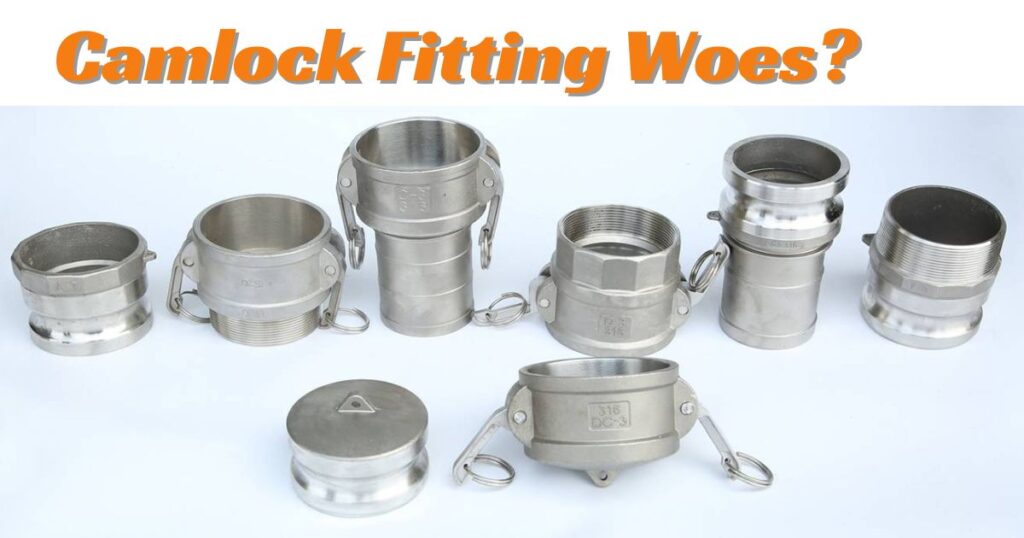Our ultimate troubleshooting guide is here to help. Discover common issues, quick fixes, and expert tips to ensure smooth operation. Say goodbye to leaks and inefficiencies with our handy guide.
It covers problems like leaks, incorrect sizing, and material compatibility. This guide provides easy-to-follow tips to help you quickly identify and resolve issues, ensuring efficient and safe fluid transfer. Perfect for both beginners and experienced professionals.
Camlock Care 101: Keeping Your Fittings Fighting Fit
Proper maintenance of camlock fittings is essential to ensure their longevity and efficiency. Start by regularly inspecting the fittings for any signs of wear and tear, such as cracks, deformities, or corrosion.
Keeping the fittings clean is crucial; accumulated dirt and debris can affect the sealing and connection. Use a soft brush and mild detergent for cleaning, and avoid harsh chemicals that could damage the material.
Lubricating the gaskets and moving parts will help maintain a good seal and prevent sticking. Also, check the coupling arms for proper alignment and tightness, as loose or misaligned arms can cause leaks.
Store the fittings in a cool, dry place when not in use, and avoid exposing them to extreme temperatures or direct sunlight.
It is also important to use the correct type of fitting material for the fluid being transferred, as compatibility issues can lead to rapid deterioration.
By following these care tips, you can extend the lifespan of your camlock fittings and ensure safe and efficient fluid transfer.
When DIY Won’t Cut It: Knowing When to Call in the Pros
While many minor issues with camlock fittings can be handled with basic troubleshooting, there are times when it’s best to call in professional help.
If you encounter persistent leaks that do not resolve with gasket replacement or tightening, it could indicate a deeper issue with the fitting’s integrity or alignment.
Similarly, if you notice unusual wear patterns or damage that seems beyond surface-level scratches, a professional assessment may be necessary to determine whether the fitting can still be safely used.
Complex installations, particularly those involving hazardous materials or requiring specialized knowledge of fluid dynamics, should also be handled by experts to ensure compliance with safety standards and regulations.
A professional can provide the precise specifications and installation if your system requires custom fittings or modifications. Finally, if you are unsure about the material compatibility or have concerns about the operational pressure and temperature limits, consulting with a specialist can prevent costly mistakes and ensure optimal performance. Knowing when to seek professional assistance can save time, reduce risks, and protect your investment in quality equipment.
Camlock Crystal Ball: Future-proofing Your Fitting Game
As technology and industry standards evolve, future-proofing your camlock fitting setup can help you avoid potential challenges.
One way to do this is by investing in fittings made from high-quality, durable materials that can withstand a wide range of fluids and operating conditions.
Consider stainless steel or high-grade aluminum for their durability and resistance to corrosion.
Keeping up with the latest advancements in camlock fitting design, such as improved sealing technologies or innovative locking mechanisms, can also provide a more secure and leak-proof connection.
It is wise to anticipate changes in industry regulations or shifts in the types of fluids you may need to transfer, ensuring your fittings are compatible with new standards or substances.
Implementing a regular maintenance schedule and keeping detailed records of inspections and replacements will help track the condition of your fittings over time.
Additionally, consider scalability in your fittings setup, allowing for easy upgrades or expansions as your operational needs grow.
By taking a proactive approach, you can minimize downtime, reduce costs, and maintain a safe and efficient fluid transfer system well into the future.
Wrapping It Up: Your Camlock Cheat Sheet
Camlock couplings, also known as cam and groove couplings, are essential components in many fluid handling systems.
These couplings are used to quickly connect and disconnect hoses and pipes, making them ideal for a wide range of applications, from industrial to agricultural.
Camlock couplings consist of two main parts: the male adapter and the female coupler, which lock together with the help of cam arms on the coupler.
They are available in various materials, such as aluminum, stainless steel, brass, and plastic, each suited for different types of fluids and environmental conditions.
What is a Camlock Coupling?
A Camlock coupling is a versatile and quick-connect fitting used for joining hoses and pipes in fluid transfer systems.
It provides a secure, leak-proof connection without the need for tools. The coupling consists of two parts: a male adapter and a female coupler, which are connected and locked together by rotating the cam arms on the coupler.
This design makes Camlocks ideal for applications that require frequent connections and disconnections, such as in chemical processing, oil and gas, and water treatment.
How do Camlocks Work?
Camlocks work by utilizing a simple yet effective mechanism. The male adapter is inserted into the female coupler, and the cam arms on the coupler are rotated down to lock the connection.
The cam arms have a camming action that pulls the adapter tightly into the coupler, creating a secure seal. This design allows for a quick and easy connection and disconnection without the need for tools.
The seal is typically maintained by gaskets located inside the coupler, which prevent leaks and ensure a tight fit. The simplicity and reliability of this mechanism make Camlocks a popular choice in various industries.
Why use Camlocks?
Camlocks are favored for their ease of use, reliability, and versatility. They provide a quick and efficient way to connect and disconnect hoses and pipes, reducing downtime and increasing productivity.
The wide range of available materials makes them suitable for handling different types of fluids, including chemicals, water, and petroleum products.
Camlocks are also durable and can withstand harsh environmental conditions, making them ideal for industrial and outdoor applications.
Their design minimizes the risk of leaks and spills, enhancing safety in fluid transfer operations. Overall, Camlocks offers a cost-effective and reliable solution for many fluid handling needs.
How to Select the Right Camlock Fitting?
Choosing the right Camlock fitting involves considering several factors. First, determine the material compatibility with the fluid you will be transferring.
Common materials include stainless steel, aluminum, brass, and plastic, each with its advantages and limitations.
Next, consider the size and type of the fitting. Camlocks come in various sizes, and it’s crucial to select the correct size for your hoses or pipes to ensure a proper fit.
Additionally, consider the pressure and temperature ratings, ensuring the fitting can handle the operating conditions of your system.
It is also essential to select the appropriate gasket material, as different gaskets are suited for different fluids and temperatures.
How to Measure the Size of a Camlock
Measuring the size of a Camlock fitting involves determining the diameter of the hose or pipe it will connect to.
The size is typically measured in inches and refers to the nominal inside diameter (ID) of the hose or pipe. To measure, use a caliper or a ruler to determine the inside diameter of the male adapter or the female coupler.
It is important to note that the nominal size does not always match the actual measurement; it is a standard size used to denote the fitting’s compatibility with hoses and pipes.
When selecting a Camlock fitting, always verify the nominal size and ensure it matches the hose or pipe size in your system.
Conclusion
Camlock Fitting Woes? Your Ultimate Troubleshooting Guide for Industrial Fluid Transfer” provides practical advice to tackle common problems with camlock fittings, helping you maintain a safe and efficient fluid transfer system. By following the guide’s tips on identifying issues, performing routine maintenance, and knowing when to seek professional help, you can keep your fittings in top shape and avoid costly downtime. This essential resource ensures you’re well-prepared to handle any camlock challenges that come your way.







